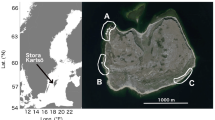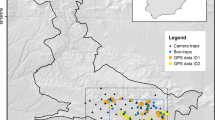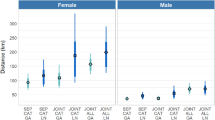Abstract
Capture–recapture (CR) models assume marked individuals remain at risk of capture, which may not be true if individuals lose their mark or emigrate definitively from the study area. Using a double-marking protocol, with a main and auxiliary mark, and both live encounters and dead recoveries at a large scale, partially frees CR models from this assumption. However, the auxiliary mark may fall off and its presence is often not mentioned when dead individuals are reported. We propose a new model to deal with heterogeneity of detection and uncertainty of the presence of an auxiliary mark in a multi-event framework. Our general model, based on a double-marking protocol, uses information from physical captures/recaptures, distant observations and main mark recoveries from dead animals. We applied our model to a 13-year data set of a harvested species, the Greater Snow Goose. We obtained seasonal survival estimates for adults of both sexes. Survival estimates differed between models where the presence of the auxiliary mark upon recovery was ignored versus those where the presence was accounted for. In the multi-event framework, seasonal survival estimates are no longer biased because the heterogeneity due to the presence of an auxiliary mark is accounted for in the estimation of recovery rates.
Note: An illustration of the implementation of our model in E-SURGE is available online.
Similar content being viewed by others
References
Alisauskas, R. T., and Lindberg, M. S. (2002), “Effects of neckbands on survival and fidelity of white-fronted and Canada geese captured as non-breeding adults,” Journal of Applied Statistics, 29, 521–537.
Alisauskas, R. T., Drake, K. L., Slattery, S. M., and Kellett, D. K. (2006), “Neckbands, harvest, and survival of Ross’s geese from Canada’s central arctic,” Journal of Wildlife Management, 70, 89–100.
Ballou, R. M., and Martin, F. W. (1964), “Rigid plastic collars for marking geese,” Journal of Wildlife Management, 28, 846–847.
Brownie, C. (1985), Statistical inference from band recovery data: a handbook, no. 156 in Resource Publication, 2nd ed., Washington, D.C., U.S.A.: U.S. Department of the Interior, Fish and Wildlife Service.
Burnham, K. P. (1993), “A theory for combined analysis of ring recovery and recapture data,” in Marked Individuals in the Study of Bird Population, eds. J.-D. Lebreton, P. M. North, Basel: Birkhauser, pp. 199–213.
Calvert, A. M., and Gauthier, G. (2005), “Effects of exceptional conservation measures on survival and seasonal hunting mortality in Greater Snow Geese,” Journal of Applied Ecology, 42, 442–452.
Calvert, A. M., Gauthier, G., and Reed, A. (2005), “Spatiotemporal heterogeneity of Greater Snow Goose harvest and implications for hunting regulations,” Journal of Wildlife Management, 69, 561–573.
Choquet, R. (2008), “Automatic generation of multistate capture–recapture models,” Canadian Journal of Statistics, 36, 43–57.
Choquet, R., Rouan, L., and Pradel, R. (2009), “Program E-SURGE: a software application for fitting multievent models,” in Modeling Demographic Processes in Marked Populations, Series: Environmental and Ecological Statistics, Vol. 3, eds. D. L. Thomson, E. G. Cooch, and M. J. Conroy, New York: Springer, pp. 845–865.
Conn, P. B., Kendall, W. L., and Samuel, M. D. (2004), “A general model for the analysis of mark-resight, mark-recapture, and band-recovery data under tag loss,” Biometrics, 60, 900–909.
Crespin, L., Choquet, R., Lima, M., Merritt, J., and Pradel, R. (2008), “Is heterogeneity of catchability in capture–recapture studies a mere sampling artifact or a biologically relevant feature of the population?” Population Ecology, 50, 247–256.
Frederiksen, M., Hearn, R. D., Mitchell, C., Sigfusson, A., Swann, R. L., and Fox, A. D. (2004), “The dynamics of hunted Icelandic goose populations: a reassessment of the evidence,” Journal of Applied Ecology, 41, 315–334.
Gauthier, G., and Lebreton, J.-D. (2008), “Analysis of band-recovery data in a multistate capture–recapture framework,” Canadian Journal of Statistics, 36, 59–73.
Gauthier, G., Pradel, R., Menu, S., and Lebreton, J.-D. (2001), “Seasonal survival of Greater Snow Geese and effect of hunting under dependence in sighting probability,” Ecology, 82, 3105–3119.
Henaux, V., Bregnballe, T., and Lebreton, J.-D. (2007), “Dispersal and recruitment during population growth in a colonial bird, the great cormorant Phalacrocorax carbo sinensis,” Journal of Avian Biology, 38, 44–57.
Hestbeck, J. B., Nichols, J. D., and Malecki, R. A. (1991), “Estimates of movement and site fidelity using mark-resight data of wintering Canada geese,” Ecology, 72, 523–533.
Kremers, W. K. (1988), “Estimation of survival rates from a mark-recapture study with tag loss,” Biometrics, 44, 117–130.
Lebreton, J.-D., Burnham, K. P., Clobert, J., and Anderson, D. R. (1992), “Modeling survival and testing biological hypotheses using marked animals: a unified approach with case studies,” Ecological Monograph, 62, 67–118.
Lebreton, J.-D., Almeras, T., and Pradel, R. (1999), “Competing events, mixtures of information and multistratum recapture models,” Bird Study, 46, 39–46.
Lebreton, J.-D., Hines, J. E., Pradel, R., Nichols, J. D., and Spendelow, J. A. (2003), “Estimation by capture–recapture of recruitment and dispersal over several sites,” Oikos, 101, 253–264.
Menu, S., Hestbeck, J. B., Gauthier, G., and Reed, A. (2000), “Effects of neckbands on survival of Greater Snow Geese,” Journal of Wildlife Management, 64, 544–552.
Menu, S., Gauthier, G., and Reed, A. (2001), “Survival of juvenile Greater Snow Geese immediately after banding,” Journal of Field Ornithology, 72, 282–290.
Nichols, J. D., and Hines, J. E. (1993), “Survival rate estimation in the presence of tag loss using joint analysis of capture–recapture and resighting data,” in Marked Individuals in the Study of Bird Population, eds. J.-D. Lebreton, and P. M. North, Basel: Birkhauser, pp. 229–243.
Nichols, J. D., Bart, J., Limpert, R. J., Sladen, W. J. L., and Hines, J. E. (1992), “Annual survival rates of adult and immature eastern population tundra swans,” Journal of Wildlife Management, 56, 485–494.
Powell, L. (2007), “Approximating variance of demographic parameters using the delta method: A reference for avian biologists,” Condor, 109, 949–954.
Pradel, R. (2005), “Multievent: an extension of multistate capture–recapture models to uncertain states,” Biometrics, 61, 442–447.
Pradel, R., and Lebreton, J.-D. (1999), “Comparison of different approaches to the study of local recruitment of breeders,” Bird Study, 46, 74–81.
Pradel, R., Gimenez, O., and Lebreton, J.-D. (2005), “Principles and interest of GOF tests for multistate capture–recapture models,” Animal Biodiversity and Conservation, 28, 189–204.
Reed, E. T., Gauthier, G., Pradel, R., and Lebreton, J.-D. (2003), “Age and environmental conditions affect recruitment in Greater Snow Geese,” Ecology, 84, 219–230.
Reed, E. T., Gauthier, G., and Pradel, R. (2005), “Effects of neck bands on reproduction and survival of female Greater Snow Geese,” Journal of Wildlife Management, 69, 91–100.
Reynolds, T., King, R., Harwood, J., Frederiksen, M., Harris, M., and Wanless, S. (2009), “Integrated data analysis in the presence of emigration and mark loss,” Journal of Agricultural, Biological, and Environmental Statistics, 14, 411–431.
Rouan, L., Choquet, R., and Pradel, R. (2009), “A general framework for modeling memory in capture–recapture data,” Journal of Agricultural, Biological, and Environmental Statistics, 14, 338–355.
Samuel, M. D., Rusch, D. H., and Craven, S. (1990), “Influence of neck bands on recovery and survival rates of Canada geese,” Journal of Wildlife Management, 54, 45–54.
Samuel, M. D., Goldberg, D. R., Smith, A. E., Baranyuk, V. V., and Cooch, E. G. (2001), “Neckband retention for Lesser Snow Geese in the western Arctic,” Journal of Wildlife Management, 65, 797–807.
Zicus, M. C., Schultz, D. F., and Cooper, J. A. (1983), “Canada goose mortality from neckband icing,” Wildlife Society Bulletin, 11, 286–290.
Author information
Authors and Affiliations
Corresponding author
Electronic Supplementary Material
Rights and permissions
About this article
Cite this article
Juillet, C., Choquet, R., Gauthier, G. et al. A Capture–Recapture Model with Double-Marking, Live and Dead Encounters, and Heterogeneity of Reporting Due to Auxiliary Mark Loss. JABES 16, 88–104 (2011). https://doi.org/10.1007/s13253-010-0035-5
Accepted:
Published:
Issue Date:
DOI: https://doi.org/10.1007/s13253-010-0035-5




